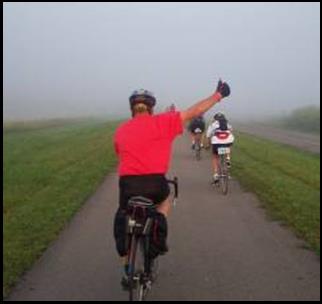Bicycle Clothes Explained
By Dan Sheridan
Originally Published in Marion Star May 17, 2009
Bicyclists are often asked “What’s with those funny looking clothes?”
Many cyclists manage without special clothing. For short trips around town, almost anything will do. I’ve seen cyclists ride 100 miles in a day wearing blue jeans, but experienced cyclists learn to wear more comfortable clothing. Bicycle clothes are designed for comfort, safety, and convenience.
Bicycle shorts may be the most important key to a comfortable ride, since much of the rider’s weight rests on the bicycle seat.
The seams in the crotch of traditional pants can be quite uncomfortable on a long bicycle ride. Bicycle shorts have a padded insert for comfort. They are typically made of a slippery and stretchy material, such as lycra, to allow easy leg movement and to avoid chafing as the legs rub against the seat.
Cycling tights are good for keeping legs warm in cooler weather. The tight, stretchy material does not flap in the wind or catch in bicycle chains. Thicker tights are available for cool weather riding. Most tights are black, which does not show dirt.
Gloves: Experienced cyclists wear padded cycling gloves that cover their palms and part of their fingers. These gloves protect the hands from numbness caused by road vibrations, and shield the hands from “road rash” if the cyclist should fall. The cloth material on the back of the gloves can be used to wipe sweat away.
Cycling Jerseys: Brightly colored cycling jerseys help motorists to see bicycles. Jerseys typically are made of a light breathable material that allows perspiration to evaporate quickly on hot days. The roomy pockets in the lower back area make a great place to carry a snack, wallet, or cell phone. I like to carry a small digital camera in my jersey pocket, so that I can easily pull it out and capture photogenic sights.
T-Shirts: Many cyclists opt for t-shirts instead of cycling jerseys, and organized bicycle rides such as the Hot Tamale Tour and the MGH Popcorn Tour have custom t-shirts available to riders.
Colorful t-shirts can also make it easy to locate friends and family members on large bicycle tours. Kathy Strickland of Searsport, Maine, sometimes rides the Great Ohio Bicycle with an extended family group that includes more than a dozen children. Before the trip, Strickland buys a large supply of similar brightly colored (yellow, orange, or tie-dye) shirts, and has the children wear the shirts around camp. This makes it easy to locate them in the midst of 2,500 campers.
Shoes: Athletic shoes are fine for shorter rides, but many riders prefer specialized cycling shoes for longer rides. These shoes have a stiff sole to distribute the pressure of the pedal across the foot. Some bicycling shoes are designed to clip into an attachment on the pedal, positioning the foot correctly and allowing the cyclist to gain extra power by pulling up on the pedal when lifting the leg. Cycling sandals are a popular variant, and let the feet dry more quickly on a warm day after a rain shower.
Socks: Thick cotton socks can be uncomfortable for cyclists who are caught in the rain. Cotton absorbs water, which sloshes back and forth with each pedal stroke. Many cyclists prefer a thin synthetic sock, and long-distance cyclists sometimes carry a dry pair of socks to change into when the rain stops.
Sunglasses: I prefer to wear wrap-around sunglasses while riding. These help to block glare, and keep wind, rain, and insects out of my eyes.
Helmet: Helmets are required on virtually all organized bicycle tours. They are well-vented, comfortable, and so light that riders barely notice them.
Bicycle clothes may be purchased in bicycle shops, as well as through many on-line vendors. Some multi-day bicycle tours offer cyclists the chance to purchase a custom jersey at a reasonable price.
Return to list of articles
Bike club home page
